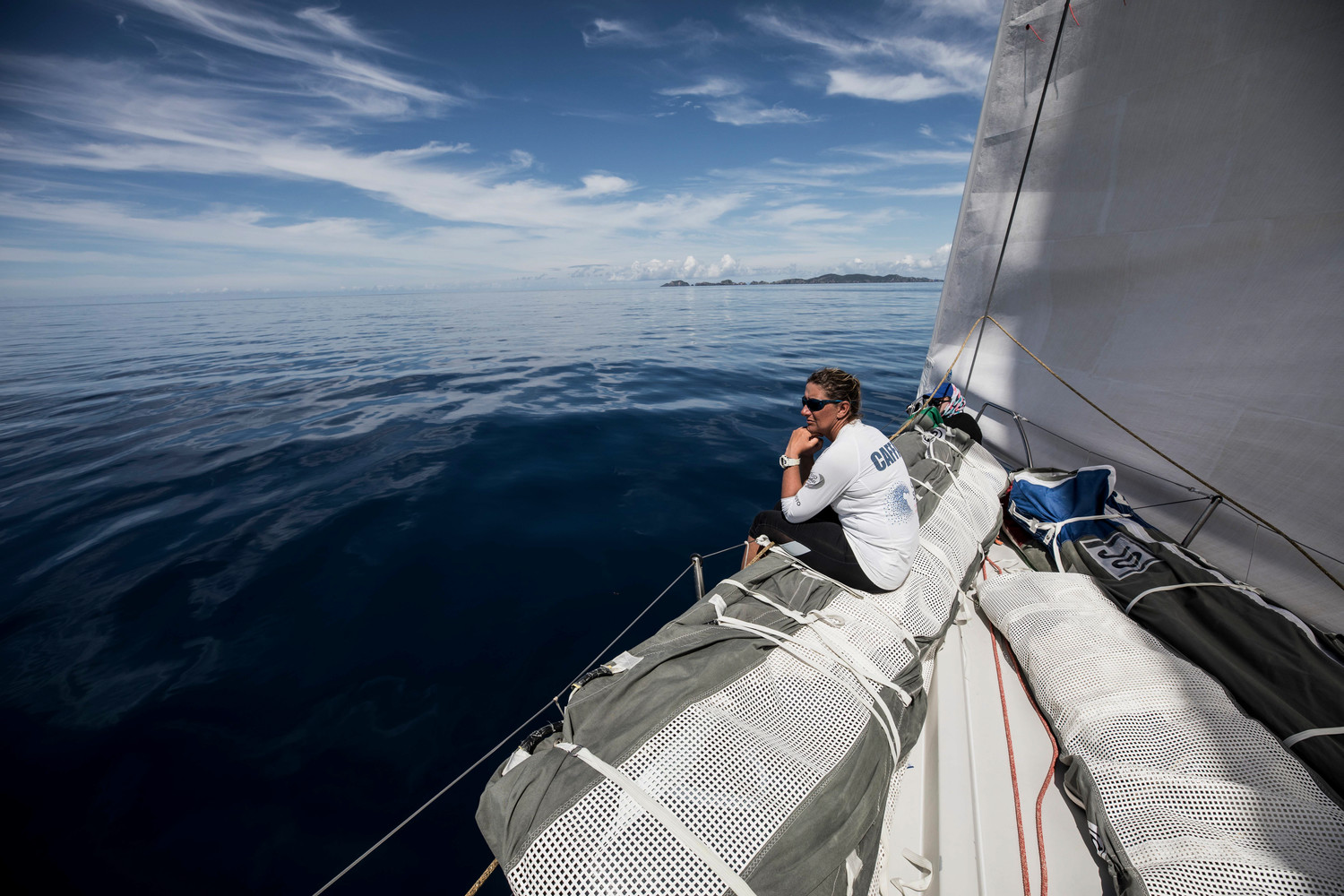
Our start out of Hong Kong was not our best. Not only did we lack speed, we didn’t get the lifts or pressure that everyone else was taking advantage of. Using the MH0 and the endless tacking did not allow us to pick up the pace for any decent manoeuvres and we often found ourselves going backwards in the current.
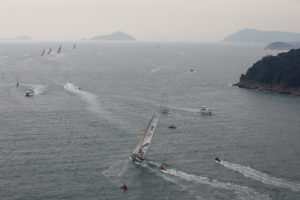
However, once clear of the leaving mark, we were off and closed the gap on the fleet. We sailed in bouncy upwind conditions during the first night where we peeled from the J1 to the J2. This is a massive change and extremely labour intensive. Since we were sailing with a new J1, we certainly didn’t want to add any risk given the windy forecast ahead. We held a full main but, in the dawn, assumed many of the fleet had stayed with the J1 and maybe added a reef as a compromise as they had gained a little on us. With hindsight, perhaps we should have sailed the conditions we saw rather than prepare for the forecast wind that never really filled in.
The timing of the tack was important. Too early would result in us sailing in the wind shadow of Taiwan and then have islands to negotiate. Too late would have us sailing extra distance. On two occasions we had stacked to tack down below decks only to be told to hold and stack back again but, in the end, we tacked alongside Dongfeng and Mapfre and were pleased with our timing.
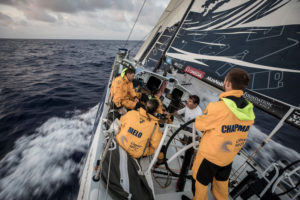
Once tacked, we rode the cold front as far as we could knowing that this would end in a light wind transition. We were sailing towards Japan and passed a few islands along the way. AkzoNobel and Scallywag had tacked early and were a long way back at this stage and we were sailing with the lead group and were pretty happy with our positioning.
We planned well for the light air transition, keeping our momentum as all four lead boats flapped their sails in the light breeze. We could hear the voices on Dongfeng and Mapfre and could see Brunel too. In fact Nico, our navigator, put it very eloquently when he said we were so close we could smell their farts!
At this transition we lost touch with the group as we chose to sail a little higher and more eastwards. AkzoNobel and Scallywag had made a huge charge and were steaming along to leeward whilst Dongfeng and Mapfre peeled off to close the gap with them. Brunel stayed with us and seemed to leave us in their wake at one stage. At this point we were all a little demoralised and questioned navigation that put us sailing higher and slightly slower than everyone else.
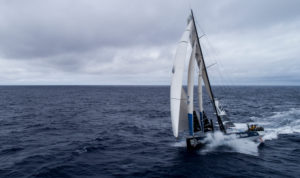
The next transition was for the doldrums where we closed with the fleet once more and we sailed right back into Brunel. We were grateful to have some luck in this section but really felt that it was our turn to have some fortune under the clouds. Two mornings we woke to see Brunel in our sights and eventually seized our opportunity to pass them. We were both flapping sails in no wind and chasing any zephyr we could. We stayed with our MH0 and Brunel changed to the J1. We both started moving, chasing clouds and where we saw more wind on the water. Eventually after 24 hours of slowly gaining momentum we sailed clear ahead of Brunel. Spirits on board lifted once more.
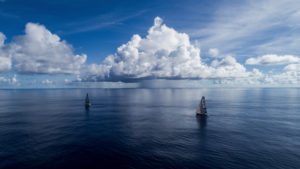
We handled the clouds and changed gears better than we had on previous legs and were reaping the rewards from progress in this area. 1500 miles to go and we turned into the light wind rocket ship with New Caledonia and its outlying reefs as our next obstacle. We passed through the Great Passage between the two large reefs at the end of the island as AkzoNobel and Scallywag simultaneously passed round the outside of these reefs. Brunel followed in our path and Mapfre and Dongfeng forged a new channel through a very small gap.
AkzoNobel and Scallywag now benefitted from greater breeze away from the island, but we kept going south to clear the light winds and find wind to match that being experienced by the two lead boats. At this point, Brunel went into stealth mode and we were increasing the gap between us and the two red boats nicely.
There were a few options to Auckland but none were that obvious or clear. We elected to follow a more circular route, adding miles to our route but remaining in stronger winds. We were closing on the front runners and the runway was reducing fast with the boats behind us heading in a more direct route to Auckland. The breeze was shifty in pressure and direction, but we just needed to be fast. To the north of us was a high pressure we were rounding and the breeze we wanted was to the south.
Approaching New Zealand, the breeze was forecast to drop and we were conscious that this could mean an effective fleet re start. Fortunately, a secondary low formed on a cold front that was heading our way and helped clear the light winds away from us which allowed us to keep moving and, more importantly, kept the boats behind us where they were. Now that we didn’t have to look over our shoulders, we focussed on the two boats ahead and what we could do to make gains on them.
The breeze was reluctant to drop and lift fully which provided us with extra speed on the penultimate day. We then hit groundhog day, with the same angle, same speed and same conditions for the last several days but it was champagne sailing so there are far worse ways to reach the end of a leg. As the wind lifted so did our course but on board we made no real changes and just stayed focussed on sailing fast.
The first sight of land coincided with our first shut down on the approach to Auckland. The boats ahead slowed with us but thankfully this was after we had closed the gap and had them firmly in our sights. We then spent a painful few night time hours trying to get round Murinotu Island and get free of the weak land breeze and transition to the gradient breeze offshore. The two opposing breezes made us tack many times to locate the best pressure and get the lifts to enable us to clear the land. You can easily differentiate between land and offshore breezes with a land breeze having a very distinct smell.
We made our way to Cape Brett in a weak building breeze as the sun rose in the sky. The other competitors stayed inshore while we elected to remain offshore. We hoped the sea breeze would build later, allowing us better pressure offshore, however it was not to be and the nightmare scenario played out. There was a complete shut down, the sea turned to glass and the odd zephyr enabled us to keep moving. The good news was that we closed on the front runners AkzoNobel and Scallywag, the bad news was that Mapfre and Dongfeng did the same to us from behind. Suddenly we were all within 8 miles of each other and it seemed as though this race was to be a 5100 mile warm up ahead of a 100 mile race into Auckland Harbour. Not only were we trying to keep moving and try to position ourselves against the two boats in front but now we found ourselves having to defend against the red boats coming up from behind. Exactly what where we didn’t want to be at this stage of the race.
All the action happened in the final few miles and last 4 hours of this 21 day leg. We all picked up the new breeze that Mapfre and Dongfeng had been capitalising on and our boat speed built shorty after AkzoNobel and Scallywag had picked up the pace. Like everyone else, we were pushing hard, and then a cloud took us from 12 knots to 25 knots. The wind filled and stayed and it was all on for the last 60 miles. As we closed in on Auckland Harbour we had traffic, buoy-age and land masses to negotiate, all the while fending off the two red boats on our tail. We held them off matching boat speed and hanging onto our MH0 when slightly overpowered with the full team on deck working hard. Mapfre had a different sail combination up and eventually overtook us. We were now sandwiched between the red boats and were approaching Rangitoto Island fast. We all gybed at the same time but our boat speed dropped. We were struggling to get the boat going but did not have time to find out why apart from having an outrigger issue after the gybe. The next gybe was 10 minutes later and it was a bad one. We wiped out with Dongfeng taking the advantage. With 30 knots of wind we were sailing at 22knots of boat speed, our two boats side by side, but Dongfeng had the edge and our fate was sealed. We finished in 5th place in what was probably the closest finish of a Volvo Ocean Race fleet.
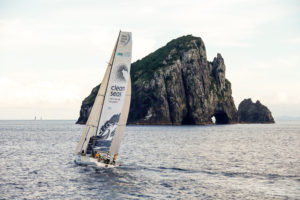
As legs go, it was fast, exciting and our best sailing to date. Yet again though it was not the result I feel we deserved and we were gutted. The team deserved much more for a leg they sailed so well.
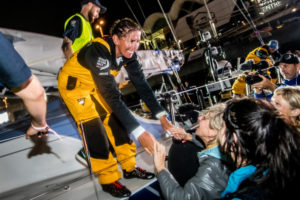
My only consolation is the fact that, once we hit land, everyone else seemed as frustrated by that finish as us, including sailors in the other teams. With such a tight and hard fought leg, people are starting to take notice of what we can achieve and our ability to pose a serious threat to our competitors.